Skema DSPL
Tetap teratur dengan koleksi
Simpan dan kategorikan konten berdasarkan preferensi Anda.
Halaman ini dan sub-halamannya yang tertaut mendokumentasikan skema XML DSPL.
Materi ini ditujukan untuk pengguna tingkat lanjut yang ingin memahami
detail bahasa tingkat rendah; bagi sebagian besar pengguna, konten
di
Panduan Developer seharusnya memadai untuk membuat dan mengedit
Set data DSPL.
Skema XML lengkap tersedia untuk didownload dalam format XSD
pada
Situs kode DSPL.
Elemen: dspl
| Namespace |
http://schemas.google.com/dspl/2010 |
| Anotasi |
Spesifikasi DSPL menggambarkan set data. Sebuah {i>dataset<i} adalah
diidentifikasi berdasarkan namespace. {i>Dataset<i} terdiri dari hal-hal berikut
elemen: - Tabel: Data untuk konsep dan potongan yang didefinisikan dalam
- Konsep: Definisi dan struktur yang ditentukan pengguna yang digunakan dalam
set data - Slice: Kombinasi dimensi dan metrik yang ada dalam
kumpulan data - Topik: Label hierarkis yang digunakan untuk mengatur konsep
set data |
| Diagram |
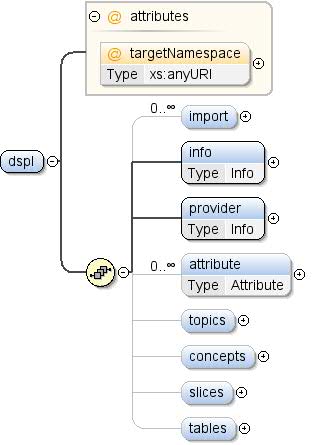 |
| Properti |
|
| Model |
import* , info , provider ,
atribut* , topik{0,1} , konsep{0,1} , irisan{0,1} , tabel{0,1} |
| Anak-Anak |
atribut, konsep, impor,
info, penyedia, slice,
tabel, topik |
| Instance |
<dspl targetNamespace="">
<import location="" namespace="">{0,unbounded}</import>
<info>{1,1}</info>
<provider>{1,1}</provider>
<attribute concept="" id="">{0,unbounded}</attribute>
<topics>{0,1}</topics>
<concepts>{0,1}</concepts>
<slices>{0,1}</slices>
<tables>{0,1}</tables>
</dspl>
|
| Atribut |
| QName |
Jenis |
Tetap |
Default |
Gunakan |
Annotation |
| targetNamespace |
xs:anyURI |
|
|
opsional |
Setiap set data dapat menyediakan namespace target. Target
adalah URI yang mengidentifikasi set data secara unik. Untuk selengkapnya
informasi tentang penggunaan namespace di XML, lihat:
http://www.w3.org/TR/REC-xml-names/ Jika tidak ada targetNamespace yang
maka namespace akan dibuat saat set data
diimpor. |
|
| Sumber |
<xs:element name="dspl">
<xs:annotation>
<xs:documentation>A DSPL specification describes a dataset. A dataset is
identified by its namespace. A dataset is comprised of the
following elements:
- Tables: Data for the concepts and slices defined in the
dataset
- Concepts: User-specified definitions and structures used in
the dataset
- Slices: Combinations of dimensions and metrics present in
the dataset
- Topics: Hierarchical labels used to organise the concepts of
the dataset</xs:documentation>
</xs:annotation>
<xs:complexType>
<xs:sequence>
<xs:element name="import" minOccurs="0" maxOccurs="unbounded">
<xs:annotation>
<xs:documentation>Import directive for external datasets -- modeled after
the XML Schema import directive. In order to use
elements defined in an external dataset, the external
dataset must be referenced using an import directive.</xs:documentation>
</xs:annotation>
<xs:complexType>
<xs:attribute name="namespace" use="required">
<xs:annotation>
<xs:documentation>The namespace of the imported dataset, specified as
a URI. A prefix must be associated with this
namespace before its contents can be referenced. See
[XML Namespaces] for more information about the use
of namespaces and prefixes in XML.</xs:documentation>
</xs:annotation>
</xs:attribute>
<xs:attribute name="location" use="optional">
<xs:annotation>
<xs:documentation>An optional location where the definition of the
imported dataset can be found, specified as a
URL. If the location is omitted, the system
processing this DSPL dataset must already know the
imported dataset.
Implementation note: The Google dataset importer
ignores the location attribute. Any imported dataset
must be known by the Google importer beforehand.</xs:documentation>
</xs:annotation>
</xs:attribute>
</xs:complexType>
</xs:element>
<xs:element name="info" type="Info" minOccurs="1">
<xs:annotation>
<xs:documentation>General information about the dataset.</xs:documentation>
</xs:annotation>
</xs:element>
<xs:element name="provider" type="Info">
<xs:annotation>
<xs:documentation>General information about the dataset provider.</xs:documentation>
</xs:annotation>
</xs:element>
<xs:element name="attribute" type="Attribute" minOccurs="0" maxOccurs="unbounded">
<xs:annotation>
<xs:documentation>Attribute associated with the dataset.</xs:documentation>
</xs:annotation>
</xs:element>
<xs:element name="topics" minOccurs="0">
<xs:annotation>
<xs:documentation>A hierarchy of topics used to organize the contents of
the dataset. The order in which topics are given is
meaningful and should be respected by visualizations
that displays these topics.</xs:documentation>
</xs:annotation>
<xs:complexType>
<xs:sequence>
<xs:element name="topic" type="Topic" maxOccurs="unbounded"/>
</xs:sequence>
</xs:complexType>
</xs:element>
<xs:element name="concepts" minOccurs="0">
<xs:annotation>
<xs:documentation>A list of concepts defined in this dataset.</xs:documentation>
</xs:annotation>
<xs:complexType>
<xs:sequence>
<xs:element name="concept" type="Concept" maxOccurs="unbounded"/>
</xs:sequence>
</xs:complexType>
</xs:element>
<xs:element name="slices" minOccurs="0">
<xs:annotation>
<xs:documentation>A list of slices defined in this dataset.</xs:documentation>
</xs:annotation>
<xs:complexType>
<xs:sequence>
<xs:element name="slice" type="Slice" maxOccurs="unbounded"/>
</xs:sequence>
</xs:complexType>
</xs:element>
<xs:element name="tables" minOccurs="0">
<xs:annotation>
<xs:documentation>A list of tables defined in this dataset.</xs:documentation>
</xs:annotation>
<xs:complexType>
<xs:sequence>
<xs:element name="table" type="Table" maxOccurs="unbounded"/>
</xs:sequence>
</xs:complexType>
</xs:element>
</xs:sequence>
<xs:attribute name="targetNamespace" type="xs:anyURI" use="optional">
<xs:annotation>
<xs:documentation>Each dataset may provide a target namespace. The
target namespace is a URI that uniquely identifies the
dataset. For more information about the use of namespaces in XML,
see:
http://www.w3.org/TR/REC-xml-names/
If no targetNamespace is provided, then a namespace will be
generated when the dataset is imported.</xs:documentation>
</xs:annotation>
</xs:attribute>
</xs:complexType>
</xs:element>
|
Elemen: dspl / import
| Namespace |
http://schemas.google.com/dspl/2010 |
| Anotasi |
Perintah impor untuk set data eksternal -- dibuat sesuai model XML
Perintah impor skema. Untuk menggunakan elemen yang didefinisikan dalam eksternal
, set data eksternal harus dirujuk menggunakan impor
perintah. |
| Diagram |
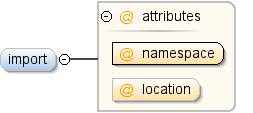 |
| Properti |
| konten: |
kompleks |
| minimum: |
0 |
| maxOccurs: |
tanpa batas |
|
| Atribut |
| QName |
Jenis |
Tetap |
Default |
Gunakan |
Annotation |
| lokasi |
|
|
|
opsional |
Lokasi opsional tempat definisi lokasi yang diimpor
dapat ditemukan, ditentukan sebagai URL. Jika lokasinya adalah
dihilangkan, sistem yang memproses set data DSPL ini harus mengetahui
set data yang diimpor. Catatan penerapan: Set data Google
pengimpor mengabaikan atribut location. Set data yang diimpor harus
diketahui oleh pengimpor Google terlebih dahulu. |
| namespace |
|
|
|
wajib diisi |
Namespace set data yang diimpor, ditentukan sebagai
URI. Awalan harus dikaitkan dengan namespace ini sebelum
kontennya dapat dirujuk. Lihat [XML Namespaces] untuk informasi selengkapnya
informasi tentang penggunaan namespace dan awalan dalam
XML. |
|
| Sumber |
<xs:element name="import" minOccurs="0" maxOccurs="unbounded">
<xs:annotation>
<xs:documentation>Import directive for external datasets -- modeled after
the XML Schema import directive. In order to use
elements defined in an external dataset, the external
dataset must be referenced using an import directive.</xs:documentation>
</xs:annotation>
<xs:complexType>
<xs:attribute name="namespace" use="required">
<xs:annotation>
<xs:documentation>The namespace of the imported dataset, specified as
a URI. A prefix must be associated with this
namespace before its contents can be referenced. See
[XML Namespaces] for more information about the use
of namespaces and prefixes in XML.</xs:documentation>
</xs:annotation>
</xs:attribute>
<xs:attribute name="location" use="optional">
<xs:annotation>
<xs:documentation>An optional location where the definition of the
imported dataset can be found, specified as a
URL. If the location is omitted, the system
processing this DSPL dataset must already know the
imported dataset.
Implementation note: The Google dataset importer
ignores the location attribute. Any imported dataset
must be known by the Google importer beforehand.</xs:documentation>
</xs:annotation>
</xs:attribute>
</xs:complexType>
</xs:element>
|
Elemen: dspl / info
| Namespace |
http://schemas.google.com/dspl/2010 |
| Anotasi |
Informasi umum tentang set data. |
| Diagram |
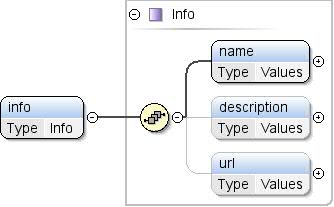 |
| Jenis |
Info |
| Properti |
| konten: |
kompleks |
| minimum: |
1 |
|
| Model |
name , description{0,1} , url{0,1} |
| Anak-Anak |
description, name, url |
| Instance |
<info>
<name>{1,1}</name>
<description>{0,1}</description>
<url>{0,1}</url>
</info>
|
| Sumber |
<xs:element name="info" type="Info" minOccurs="1">
<xs:annotation>
<xs:documentation>General information about the dataset.</xs:documentation>
</xs:annotation>
</xs:element>
|
Elemen: dspl / provider
| Namespace |
http://schemas.google.com/dspl/2010 |
| Anotasi |
Informasi umum tentang penyedia set data. |
| Diagram |
 |
| Jenis |
Info |
| Properti |
|
| Model |
name , description{0,1} , url{0,1} |
| Anak-Anak |
description, name, url |
| Instance |
<provider>
<name>{1,1}</name>
<description>{0,1}</description>
<url>{0,1}</url>
</provider>
|
| Sumber |
<xs:element name="provider" type="Info">
<xs:annotation>
<xs:documentation>General information about the dataset provider.</xs:documentation>
</xs:annotation>
</xs:element>
|
Elemen: dspl / atribut
| Namespace |
http://schemas.google.com/dspl/2010 |
| Anotasi |
Atribut yang terkait dengan set data. |
| Diagram |
 |
| Jenis |
Atribut |
| Properti |
| konten: |
kompleks |
| minimum: |
0 |
| maxOccurs: |
tanpa batas |
|
| Model |
info{0,1} , type{0,1} , (nilai*
| conceptValue{0,1}) |
| Anak-Anak |
conceptValue, info, type,
nilai |
| Instance |
<attribute concept="" id="">
<info>{0,1}</info>
<type format="" ref="">{0,1}</type>
</attribute>
|
| Atribut |
| QName |
Jenis |
Tetap |
Default |
Gunakan |
Annotation |
| konsep |
xs:QName |
|
|
opsional |
Referensi ke konsep yang sesuai dengan nilai-nilai
dari atribut. Jika atribut menentukan tipe, maka tipe
harus cocok dengan jenis konsep yang dirujuk. Referensi ke
konsep eksternal harus berbentuk
"prefix:other_Concept_id", dengan "prefix" bernilai
awalan yang digunakan untuk namespace set data eksternal (lihat XML
). |
| id |
LocalId |
|
|
opsional |
ID atribut konsep. Pengidentifikasi ini harus
unik di dalam konsep (di seluruh atribut dan properti). Tujuan
id dapat dihilangkan jika atribut konsep ditentukan. Di sana
kasus, id adalah implisit yang dibuat dengan nilai nama lokal
konsep yang direferensikan. Misalnya <attribute
concept="unit:currency"/> setara dengan
<attribute id="currency"
concept="unit:currency"/> |
|
| Sumber |
<xs:element name="attribute" type="Attribute" minOccurs="0" maxOccurs="unbounded">
<xs:annotation>
<xs:documentation>Attribute associated with the dataset.</xs:documentation>
</xs:annotation>
</xs:element>
|
Elemen: dspl / topik
| Namespace |
http://schemas.google.com/dspl/2010 |
| Anotasi |
Hierarki topik yang digunakan untuk mengatur konten
{i>dataset<i} aslinya. Urutan topik yang diberikan harus memiliki makna dan
dipatuhi oleh visualisasi yang menampilkan topik ini. |
| Diagram |
 |
| Properti |
| konten: |
kompleks |
| minimum: |
0 |
|
| Model |
topik+ |
| Anak-Anak |
topik |
| Instance |
<topics>
<topic id="" parentTopic="">{1,unbounded}</topic>
</topics>
|
| Sumber |
<xs:element name="topics" minOccurs="0">
<xs:annotation>
<xs:documentation>A hierarchy of topics used to organize the contents of
the dataset. The order in which topics are given is
meaningful and should be respected by visualizations
that displays these topics.</xs:documentation>
</xs:annotation>
<xs:complexType>
<xs:sequence>
<xs:element name="topic" type="Topic" maxOccurs="unbounded"/>
</xs:sequence>
</xs:complexType>
</xs:element>
|
Elemen: dspl / topik / topik
| Namespace |
http://schemas.google.com/dspl/2010 |
| Diagram |
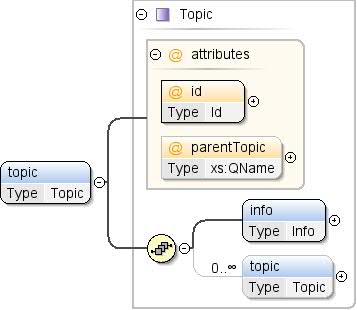 |
| Jenis |
Topik |
| Properti |
| konten: |
kompleks |
| maxOccurs: |
tanpa batas |
|
| Model |
info , topik* |
| Anak-Anak |
info, topik |
| Instance |
<topic id="" parentTopic="">
<info>{1,1}</info>
<topic id="" parentTopic="">{0,unbounded}</topic>
</topic>
|
| Atribut |
| QName |
Jenis |
Tetap |
Default |
Gunakan |
Annotation |
| id |
ID |
|
|
wajib diisi |
ID unik topik di
set data. |
| parentTopic |
xs:QName |
|
|
opsional |
ID topik induk topik ini, jika ada.
parentTopic tidak dapat ditentukan untuk topik yang disisipkan di dalam
topik lainnya. |
|
| Sumber |
<xs:element name="topic" type="Topic" maxOccurs="unbounded"/>
|
Elemen: dspl / Concept
| Namespace |
http://schemas.google.com/dspl/2010 |
| Anotasi |
Daftar konsep yang ditentukan dalam set data ini. |
| Diagram |
 |
| Properti |
| konten: |
kompleks |
| minimum: |
0 |
|
| Model |
konsep+ |
| Anak-Anak |
konsep |
| Instance |
<concepts>
<concept extends="" id="">{1,unbounded}</concept>
</concepts>
|
| Sumber |
<xs:element name="concepts" minOccurs="0">
<xs:annotation>
<xs:documentation>A list of concepts defined in this dataset.</xs:documentation>
</xs:annotation>
<xs:complexType>
<xs:sequence>
<xs:element name="concept" type="Concept" maxOccurs="unbounded"/>
</xs:sequence>
</xs:complexType>
</xs:element>
|
| Namespace |
http://schemas.google.com/dspl/2010 |
| Diagram |
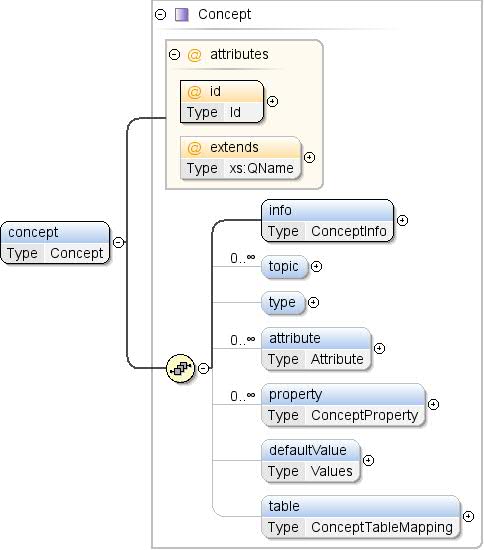 |
| Jenis |
Konsep |
| Properti |
| konten: |
kompleks |
| maxOccurs: |
tanpa batas |
|
| Model |
info , topik* , jenis{0,1} ,
attribute* , properti* , defaultValue{0,1} , tabel{0,1} |
| Anak-Anak |
attribute, defaultValue, info,
properti, tabel, topik,
jenis |
| Instance |
<concept extends="" id="">
<info>{1,1}</info>
<topic ref="">{0,unbounded}</topic>
<type ref="">{0,1}</type>
<attribute concept="" id="">{0,unbounded}</attribute>
<property concept="" id="" isMapping="false" isParent="false">{0,unbounded}</property>
<defaultValue>{0,1}</defaultValue>
<table ref="">{0,1}</table>
</concept>
|
| Atribut |
| QName |
Jenis |
Tetap |
Default |
Gunakan |
Annotation |
| memperluas |
xs:QName |
|
|
opsional |
ID unik konsep yang tidak
akan meluas. Konsep yang direferensikan dapat didefinisikan dalam {i>dataset<i} yang sama
atau secara eksternal, yaitu dalam {i>dataset <i}lain. Referensi ke eksternal
konsep harus dalam bentuk "prefix:other_konsep_id",
dengan "awalan" adalah awalan yang digunakan untuk namespace
set data eksternal (lihat namespace XML). |
| id |
ID |
|
|
wajib diisi |
ID unik konsep, yang harus
unik secara global dalam set data. |
|
| Sumber |
<xs:element name="concept" type="Concept" maxOccurs="unbounded"/>
|
Elemen: dspl / slice
| Namespace |
http://schemas.google.com/dspl/2010 |
| Anotasi |
Daftar irisan yang ditentukan dalam set data ini. |
| Diagram |
 |
| Properti |
| konten: |
kompleks |
| minimum: |
0 |
|
| Model |
slice+ |
| Anak-Anak |
slice |
| Instance |
<slices>
<slice id="">{1,unbounded}</slice>
</slices>
|
| Sumber |
<xs:element name="slices" minOccurs="0">
<xs:annotation>
<xs:documentation>A list of slices defined in this dataset.</xs:documentation>
</xs:annotation>
<xs:complexType>
<xs:sequence>
<xs:element name="slice" type="Slice" maxOccurs="unbounded"/>
</xs:sequence>
</xs:complexType>
</xs:element>
|
Elemen: dspl / slice / slice
| Namespace |
http://schemas.google.com/dspl/2010 |
| Diagram |
 |
| Jenis |
Potongan |
| Properti |
| konten: |
kompleks |
| maxOccurs: |
tanpa batas |
|
| Model |
info{0,1} , dimensi+ , metrik+
, tabel |
| Anak-Anak |
dimensi, info, metrik,
tabel |
| Instance |
<slice id="">
<info>{0,1}</info>
<dimension concept="">{1,unbounded}</dimension>
<metric concept="">{1,unbounded}</metric>
<table ref="">{1,1}</table>
</slice>
|
| Atribut |
| QName |
Jenis |
Tetap |
Default |
Gunakan |
Annotation |
| id |
ID |
|
|
wajib diisi |
ID unik slice. |
|
| Sumber |
<xs:element name="slice" type="Slice" maxOccurs="unbounded"/>
|
Elemen: dspl / tabel
| Namespace |
http://schemas.google.com/dspl/2010 |
| Anotasi |
Daftar tabel yang ditentukan dalam set data ini. |
| Diagram |
 |
| Properti |
| konten: |
kompleks |
| minimum: |
0 |
|
| Model |
tabel+ |
| Anak-Anak |
tabel |
| Instance |
<tables>
<table id="">{1,unbounded}</table>
</tables>
|
| Sumber |
<xs:element name="tables" minOccurs="0">
<xs:annotation>
<xs:documentation>A list of tables defined in this dataset.</xs:documentation>
</xs:annotation>
<xs:complexType>
<xs:sequence>
<xs:element name="table" type="Table" maxOccurs="unbounded"/>
</xs:sequence>
</xs:complexType>
</xs:element>
|
| Namespace |
http://schemas.google.com/dspl/2010 |
| Diagram |
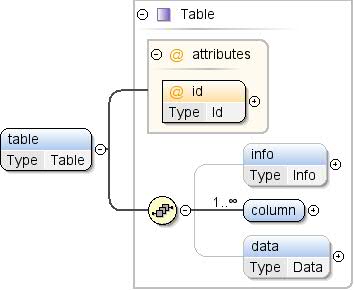 |
| Jenis |
Tabel |
| Properti |
| konten: |
kompleks |
| maxOccurs: |
tanpa batas |
|
| Model |
info{0,1} , kolom+ , data{0,1} |
| Anak-Anak |
kolom, data, info |
| Instance |
<table id="">
<info>{0,1}</info>
<column format="" id="" type="">{1,unbounded}</column>
<data>{0,1}</data>
</table>
|
| Atribut |
| QName |
Jenis |
Tetap |
Default |
Gunakan |
Annotation |
| id |
ID |
|
|
wajib diisi |
ID unik tabel di
set data. |
|
| Sumber |
<xs:element name="table" type="Table" maxOccurs="unbounded"/>
|
Atribut: dspl / import / @namespace
| Namespace |
Tidak ada namespace |
| Anotasi |
Namespace set data yang diimpor, ditetapkan sebagai URI. J
harus dikaitkan dengan namespace ini sebelum kontennya dapat
yang direferensikan. Lihat [XML Namespaces] untuk informasi lebih lanjut tentang penggunaan
namespace dan awalan dalam XML. |
| Properti |
|
| Digunakan oleh |
|
| Sumber |
<xs:attribute name="namespace" use="required">
<xs:annotation>
<xs:documentation>The namespace of the imported dataset, specified as
a URI. A prefix must be associated with this
namespace before its contents can be referenced. See
[XML Namespaces] for more information about the use
of namespaces and prefixes in XML.</xs:documentation>
</xs:annotation>
</xs:attribute>
|
Atribut: dspl / import / @location
| Namespace |
Tidak ada namespace |
| Anotasi |
Lokasi opsional tempat definisi lokasi yang diimpor
dapat ditemukan, ditentukan sebagai URL. Jika lokasi dihilangkan,
Pemrosesan sistem, set data DSPL ini harus sudah mengetahui
{i>dataset<i} aslinya. Catatan penerapan: Pengimpor set data Google mengabaikan
lokasi. Setiap set data yang diimpor harus diketahui oleh
pengimpor sebelumnya. |
| Properti |
|
| Digunakan oleh |
|
| Sumber |
<xs:attribute name="location" use="optional">
<xs:annotation>
<xs:documentation>An optional location where the definition of the
imported dataset can be found, specified as a
URL. If the location is omitted, the system
processing this DSPL dataset must already know the
imported dataset.
Implementation note: The Google dataset importer
ignores the location attribute. Any imported dataset
must be known by the Google importer beforehand.</xs:documentation>
</xs:annotation>
</xs:attribute>
|
Atribut: dspl / @targetNamespace
| Namespace |
Tidak ada namespace |
| Anotasi |
Setiap set data dapat menyediakan namespace target. Target
adalah URI yang mengidentifikasi set data secara unik. Untuk selengkapnya
informasi tentang penggunaan namespace di XML, lihat:
http://www.w3.org/TR/REC-xml-names/ Jika tidak ada targetNamespace yang disediakan,
namespace akan dibuat saat set data
diimpor. |
| Jenis |
xs:anyURI |
| Properti |
|
| Digunakan oleh |
|
| Sumber |
<xs:attribute name="targetNamespace" type="xs:anyURI" use="optional">
<xs:annotation>
<xs:documentation>Each dataset may provide a target namespace. The
target namespace is a URI that uniquely identifies the
dataset. For more information about the use of namespaces in XML,
see:
http://www.w3.org/TR/REC-xml-names/
If no targetNamespace is provided, then a namespace will be
generated when the dataset is imported.</xs:documentation>
</xs:annotation>
</xs:attribute>
|
Dibuat menggunakan
Editor XML Oksigen.
Kecuali dinyatakan lain, konten di halaman ini dilisensikan berdasarkan Lisensi Creative Commons Attribution 4.0, sedangkan contoh kode dilisensikan berdasarkan Lisensi Apache 2.0. Untuk mengetahui informasi selengkapnya, lihat Kebijakan Situs Google Developers. Java adalah merek dagang terdaftar dari Oracle dan/atau afiliasinya.
Terakhir diperbarui pada 2025-07-25 UTC.
[null,null,["Terakhir diperbarui pada 2025-07-25 UTC."],[],["The DSPL XML schema defines a dataset's structure using key components: `tables`, `concepts`, `slices`, and `topics`. The root `dspl` element encapsulates the dataset, utilizing `import` to reference externals, `info` and `provider` for metadata, `attribute` for dataset attributes, and `topics` to hierarchically organize the concepts. `concepts`, `slices`, `tables` are for concept definition, slice definition, and data table, respectively. Each element like `import`, `info`, `provider`, `attribute`, `topic`, `concept`, `slice`, `table` uses specific attributes and child elements for configuration. Each element has a specific cardinality that is defined in the document.\n"]]












